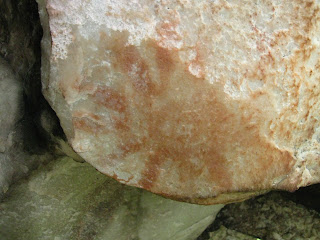Zambia is famous for it ancient schematic rock art. Northern Province has the highest concentration of rock art in Zambia and paintings are mainly found in and around rocky overhangs and caves. The most famous site is the Mwela, about 7 miles east of the town of Kasama which is a UNESCO World Heritage site. I have found sites in the Luangwa valley in the Lukusuzi National Park in the Mchinji Hills. It’s always very exciting to find them, and one often finds tools, arrow heads, primitive axes and signs of iron smelting. The paintings date back many thousands of years. The oldest in Zambia have been dated to between 350,000 and 400,000 years old! Many more are yet to be discovered. I was with my wife and some friends recently at Kapishya Hot Springs near Shiwa Ngandu. An Australian, David Bradley who has been helping out at Kapishya camp for a few weeks, wandered off into a hill 20 minutes from the camp. He saw a rock shelter with a large bright quartz rock glimmering in the sun and explored it and discovered some fantastic rock art, signs of iron smelting and primitive tools and axes. We were lucky to see it for ourselves and the day after we left further investigation found two more rock shelters with paintings and tools dating back to the Iron Age, left un-discovered for thousands of years!!
Paintings at entrance of rock shelter, the spoor art to the left could be an Eland track
Painting of the Sun?
Another Eland spoor painting to the left
Painting of the sun, apparently a rare image in Zambia rock art



















